Vice President Al Gore and Governor George Bush have released detailed documents laying out the tax and spending policies they would pursue if elected President.1 Both candidates would rely heavily on the almost $4.6 trillion in surpluses the federal government expects to collect over the next ten years. This issue brief looks at the similarities and differences in their plans and the resulting effects on the federal budget and general economy.
Bush Proposes a Bigger Tax Cut than Gore
Both candidates propose cutting taxes but differ in how and how much. Governor Bush proposes to cut taxes by $1,437.8 billion over fiscal years 2001 to 2010. That is more than 3.5 times the $394.3 billion Vice President Gore would cut.
Both the Bush and Gore tax cuts sound big until measured against the $25,655 billion that the federal government would collect over the next ten years. Using that yardstick, the Bush tax cut would shave 5.6 percent off total revenue and Gore 1.5 percent.
Both candidates would continue the trend of recent years to use the tax code to favor certain groups or activities over others. These targeted tax cuts make up all of the Gore package and one-third of the Bush proposals. The next two sections highlight the major components of each candidates tax plans.
The Bush Tax Proposals
Table 1 lists the specific tax proposals put forth in George Bush’s economic plan. A brief discussion of those which account for most of the tax cuts is given below.2
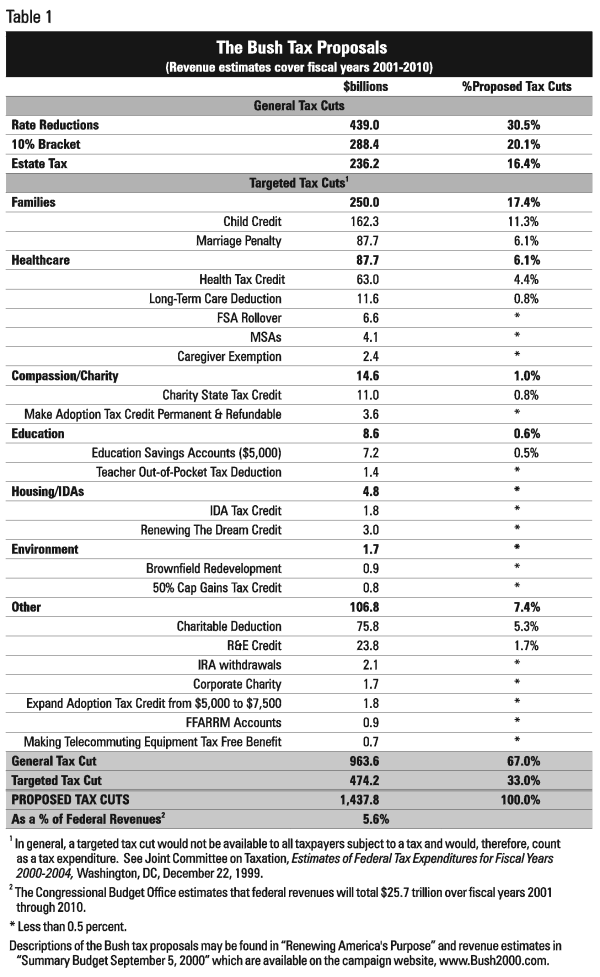
The centerpiece of the Bush tax plan is a reduction in income tax rates. He proposes to replace the current five rate brackets (15%, 28%, 31%, 36% and 39.6%) with four (10%, 15%, 25% and 33%). A new, lowest-rate bracket of 10% would be carved out from the current 15% bracket, and the top rate would drop from 39.6% to 33%. The cost of the rate reductions ($439 billion) and 10% bracket ($288.4 billion) make up half of the tax cuts.
The other broad-based tax cut is the elimination of the estate, or death tax. That along with the rate reductions account for two-thirds ($963.6 billion) of the total Bush tax cuts.
The remainder ($474.2 billion) are targeted to one degree or another. While differing in implementation, three-quarters of Bush’s targeted cuts are similar to proposals put forth in the Gore plan including:
- Child Credit: Double the current child credit from $500 to $1,000 and start the phaseout at $200,000 of income instead of the current $110,000 ($75,000 for singles). ($162.3 billion)
- Marriage Penalty: Allow 10% of the income from the lower-earning spouse to be excluded up to a maximum of $3,000. ($87.7 billion)
- Healthcare Tax Credit: Create a refundable tax credit for the uninsured or those buying their own insurance. ($63 billion)
- R&E Tax Credit: Make permanent the tax credit for research and experimentation that is set to expire in 2004. ($23.8 billion)
- Long-Term Care Deduction: Allow an above-the-line deduction for individual purchases of long-term care insurance. ($11.6 billion)
The Gore Tax Proposals
Table 2 lists the specific tax proposals put forth in Al Gore’s economic plan. A brief discussion of those which account for most of the tax cuts is given below.3
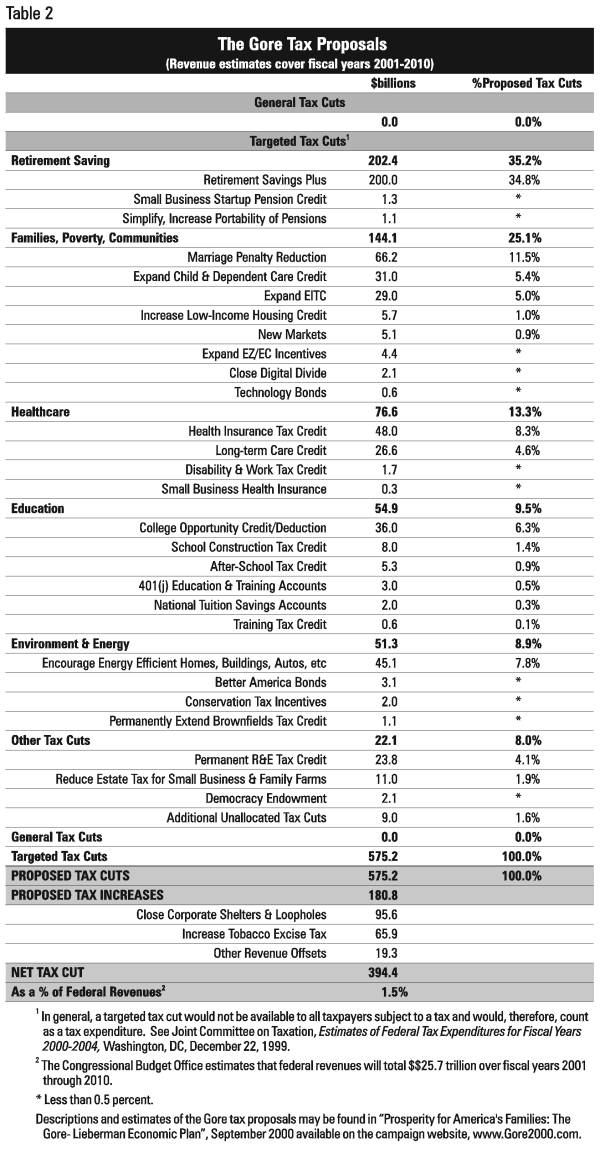
The biggest single item in the Gore tax plan is his proposal to create Retirement Savings Plus (RSP) accounts. As with traditional Individual Retirement Accounts (IRAs), contributions to RSPs would be tax deductible and earnings would accumulate tax free. Unlike IRAs, however, the government would provide a refundable, matching contribution based on the taxpayer’s income. The government would match $3 for every $1 contributed by couples with adjusted gross income (AGI) up to $30,000 ($15,000 for singles); dollar for dollar in the case of couples with AGI between $30,000 and $60,000 ($15,000 and $30,000 for singles); and $1 for every $3 in the case of couples with AGI between $60,000 and $100,000 ($30,000 and $50,000 for singles).4 Gore estimates that RSPs would cost $200 billion over the next ten years.
Gore would devote $66.2 billion to reducing the marriage penalty by raising the standard deduction for couples filing joint returns to twice that of a single taxpayer. This proposal would not help half of joint filers because they itemize.
The rest of the Gore tax package becomes even more specialized by groups or activities. Along with the RSPs and marriage penalty reduction, the following items make up 90 percent of the Gore tax cuts:
- Health Insurance: Create a 25-percent refundable tax credit for people without employer-based health insurance. ($48 billion)
- Energy Efficiency: Establish incentives for businesses to bring new environmental technologies — such as energy-efficient cars, homes, and appliances — to market and for individuals to buy them. ($45.1 billion)
- College Tuition: Increase the Lifetime Learning tax credit from 20 to 28 percent and the phase out range of incomes for joint filers from $80,000/$100,000 to $100,000/$120,000 ($50,000/$60,000 for single filers). ($36 billion)
- Child Care: Make the Child and Dependent Care Tax Credit (CDCTC) refundable for up to $2,400 of the cost of child care; increase the maximum level from 30 percent to 50 percent for families earning up to $30,000, phasing down to 20 percent for families making $60,000 or more. ($31 billion)
- Earned Income Tax Credit (EITC): Increase the phase-in rate for families with three or more children from 40 to 45 percent; extend the plateau phase-out for married couples by $2,500; reduce the phase-out rate for families with two or more children by 2 percentage points; and no longer count nontaxable income in the calculation of the EITC. ($29 billion)
- Long-term Care Credit: Create a tax credit of up to $3,000 covering a wide range of formal and informal long-term care for people of all ages with three or more limitations of activities in daily living or a comparable cognitive impairment. The tax credit would phase out for taxpayers who have a modified AGI above $110,000. ($26.6 billion)
- R&E Tax Credit: Make permanent the tax credit for research and experimentation that is set to expire in 2004. ($23.8 billion)
While proposing $575.1 billion in tax cuts, Al Gore would increase taxes by $180.8 billion.5 He expects to raise $95.6 billion through closing corporate shelters and other loopholes, $65.9 billion from a hike in the tobacco excise tax and $19.3 billion through miscellaneous other revenue raisers.6
Gore Proposes to Increase Spending More than Bush
The Gore plan proposes to increase federal outlays by $975.9 billion over the next ten years. After $75.7 billion in offsets, net new spending would rise by $900.2 billion, or 4.3%, over what is expected under current law. George Bush proposes $353.9 billion in new spending and offsets of $196.4 billion. Net new spending would rise $157.5 billion, or 0.6 percent, over current law. [Tables 3 and 4 contain specific spending proposals for Gore and Bush.]
More than a third of Gore’s spending and over two-thirds of Bush’s would concentrate on the health.
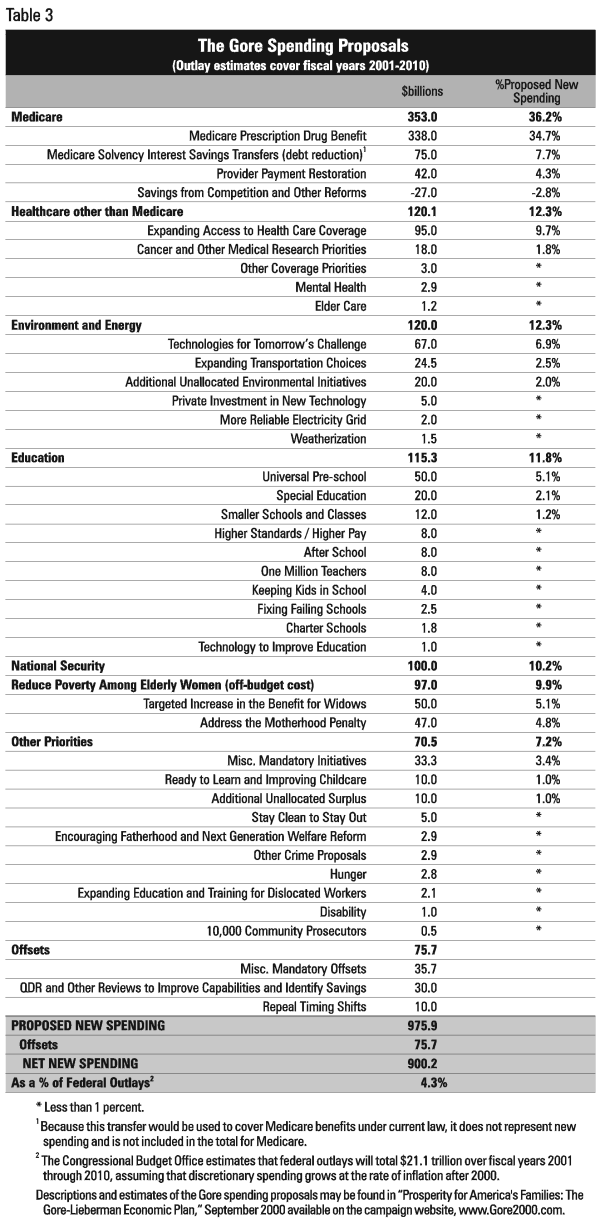
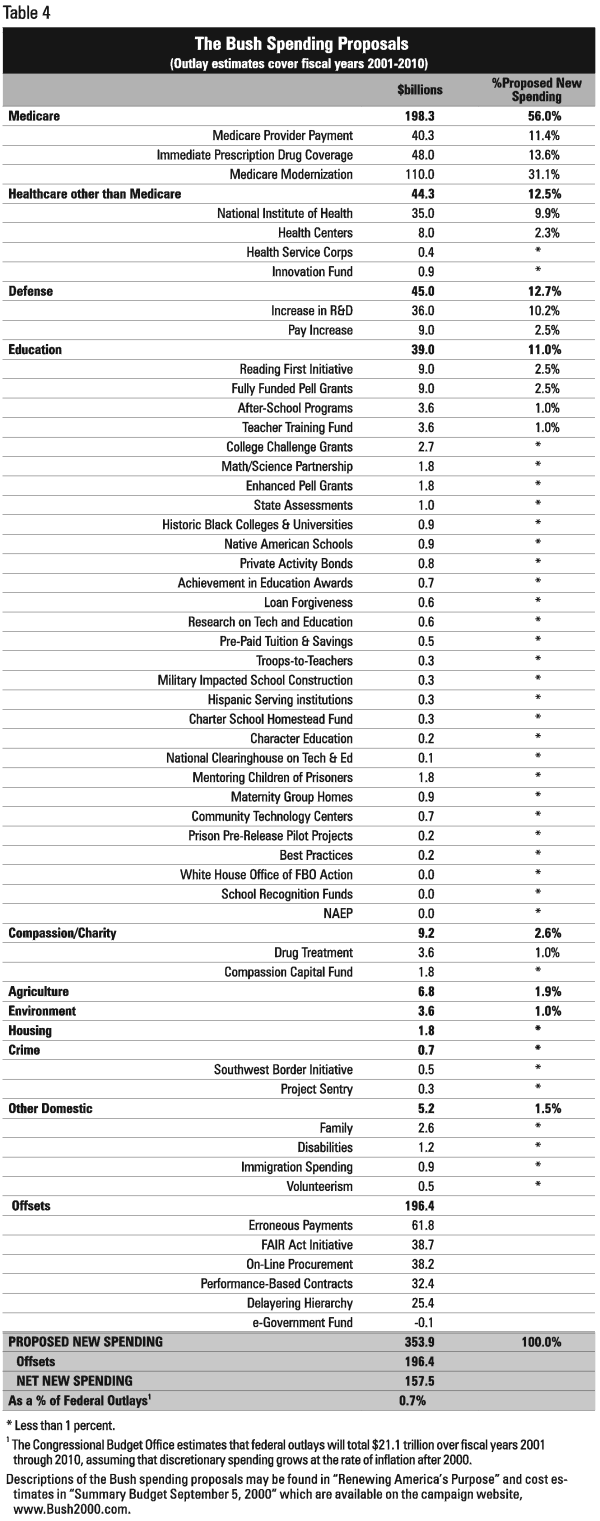
Medicare
While the biggest item for both candidates would be a new, Medicare prescription drug benefit, their approaches differ. Gore would expand the existing Medicare program by adding prescription drugs to the list of covered benefits.
To help pay for the new benefit, he would institute a new premium similar to the one for Medicare Part B. For those electing to participate, Medicare would pick up half the costs of outpatient prescription drugs from the first dollar up to $5,000 (when fully phased in) and would limit out-of-pocket spending to $4,000. Starting at $300 in 2002, the annual premium is projected to rise to $600 by 2009. Participants with incomes below 135 percent of poverty would pay nothing. After taking out the $166 billion that the new premium would raise, the Gore campaign puts the ten-year cost of the new prescription drug benefit at $338 billion. Another $47 billion would go to increase the payments to hospitals, rural providers, teaching facilities, home health care agencies, nursing homes and managed care plans while $27 billion in savings are to be realized from reform.
Bush would cover prescription drugs as part of comprehensive Medicare reform that relies on a market-based approach. Medicare participants could choose among private plans that would include prescription drug coverage and could change plans once a year without penalty. The government would subsidize the premiums on a sliding scale based on income, and no senior would have to pay more than $6,000 annually out-of-pocket for medical expenses. Bush also would provide immediate prescription drug assistance for low-income seniors and increase provider payments. His Medicare proposals would cost $198.3 billion between 2001 and 2010.
Other spending on health
Gore’s other major health initiative is an expansion of the State Children’s Health Insurance Program (SCHIP). Enacted in 1997 and administered by states through Medicaid or a separate program, SCHIP provides health insurance to uninsured, low-income children. Following the proposal in the President Clinton’s budget, Gore would extend SCHIP to uninsured parents and accelerate enrollment of children at a cost of $95 billion over ten years.
Bush proposes to spend more on medical research by giving an extra $35 billion to the National Institute of Health between 2001 and 2010.
Social Security
Neither candidate provides much detail about how he would address the looming financial crisis in Social Security. By 2015, promised benefits will be more than revenue from payroll taxes and the taxation of Social Security benefits.7 At that point the government will have to start redeeming Treasury bonds held by the trust fund. But, the only way the government can do that is to either cut spending somewhere else in the budget, raise taxes or borrow. By 2037, the trust fund will not have any more bonds to redeem.
Al Gore would devote the interest savings from paying down the debt to Social Security, thereby extending the life of the trust fund to 2054.8 That gives the trust fund more bonds but does not address the question of where the money will come from when it is time to redeem them. Gore also would increase benefits to women who stay at home to raise children and to widows at a cost of $97 billion over the next ten years.9 Last, he argues that his Retirement Savings Plan, discussed above, would provide added retirement security.
Up to 2015, Social Security will be taking in more than it needs to pay benefits. George Bush would give workers the option of redirecting some of the surplus payroll taxes into new personal retirement accounts. While these accounts should earn a considerably higher return than Social Security, there are no details about exactly how the two would interface.10
What the Gore and Bush Plans Would Mean for the Budget:
A Static Analysis
Both candidates are promising to spend more, cut taxes, reform Medicare while adding prescription drug coverage, protect Social Security, pay down the debt and keep the economy prosperous. As just discussed, they would take somewhat different approaches. Al Gore would add $900 billion in new spending and cut taxes by just under $400 billion. George Bush would cut taxes by a little over $1.4 trillion while adding roughly $160 billion to spending.
Just what could be the long-term effects of these two different prescriptions on the federal budget and the U.S. economy? This section looks at that question using static analysis which assumes that changes in tax and spending policy have no effect on the economy. The next section uses dynamic analysis which incorporates economic effects resulting from the proposed changes in fiscal policy into the budget estimates.
Both static and dynamic analysis first requires a baseline, that is, a forecast of what is likely to happen if there are no policy changes. This study uses the one prepared by the Congressional Budget Office (CBO) last July which assumes that discretionary spending increases with the rate of inflation.11
Table 5 shows that under this budget scenario federal revenues would total almost $25.7 trillion and federal outlays $21.1 trillion for fiscal years 2001 through 2010.. Because revenues are expected to grow faster than outlays, federal surpluses would amount to almost $4.6 trillion between 2001 and 2010 and $9.6 trillion between 2011 and 2020.
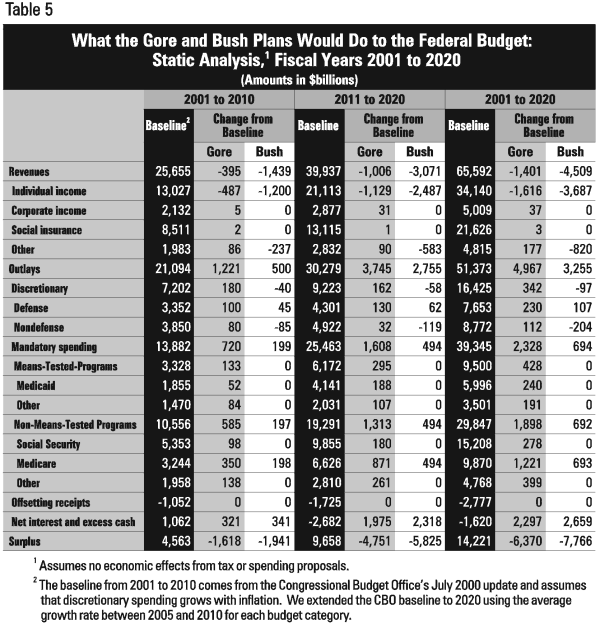
Gore’s extra spending and tax cuts would reduce surpluses in the first ten-year period by $1.6 trillion or 35 percent. The Bush proposals would reduce them by $1.9 trillion or 42 percent. Surpluses during the second ten-year period would be cut in half by the Gore plan and 60 percent by the Bush plan. At the end of twenty years, the Bush plan would reduce the cumulative, $14.2 trillion surplus by slightly more than the Gore plan (55% versus 45%). About a third of the reduction in surpluses for both candidates would be due to higher interest payments.
Nevertheless, Gore and Bush would both pay off debt in the hands of the public and at roughly the same time. When debt is paid off, interest reported in the budget turns negative. As Figure 1 shows, federal debt would be paid off sometime during fiscal year 2010 under the baseline. Using static estimates, the Gore plan would pay off the debt during 2013 and the Bush plan during 2014.
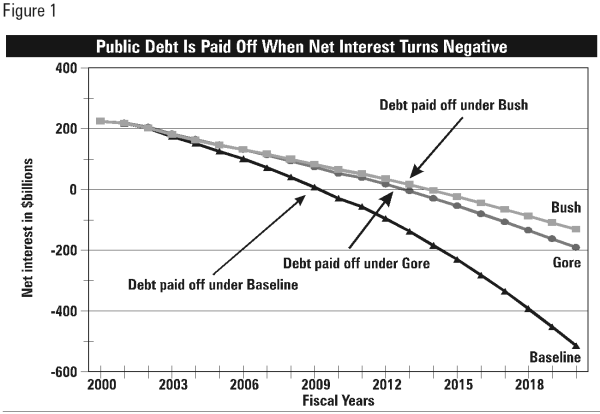
Comparing these large budget numbers with the U.S. economy helps put them in better context. As Figure 2 shows, the CBO baseline has federal revenues slowing trending down from 20.6 percent of GDP today to 20 percent by 2010. Because of proposed tax cuts, revenues would decline to 19.5 percent of GDP under the Gore plan and 18.5 percent under the Bush plan. By 2020, revenues would amount to 19.2 percent of GDP under Gore and 18.2 under Bush, compared to 19.7 percent under present law.
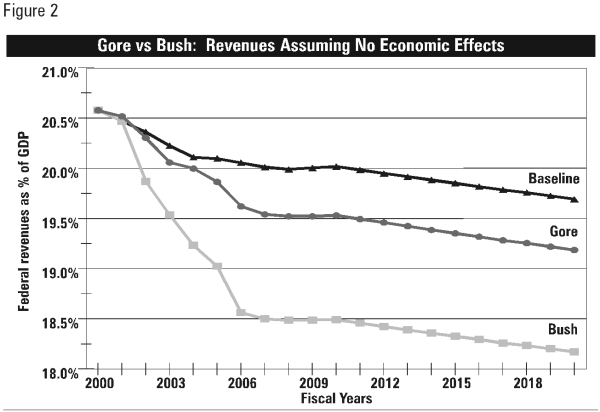
As Figure 3 shows, if discretionary spending grew only as fast as inflation, total federal spending would decline from 18.2 percent of GDP today to 15.6 percent by 2010. Because of new spending initiatives, outlays would decline somewhat less – to 16.9 percent under the Gore plan and 16.4 percent under the Bush plan. By 2020, the federal government would spend 17.1 percent under Gore and 16.6 under Bush, compared to 14.8 percent under present law.
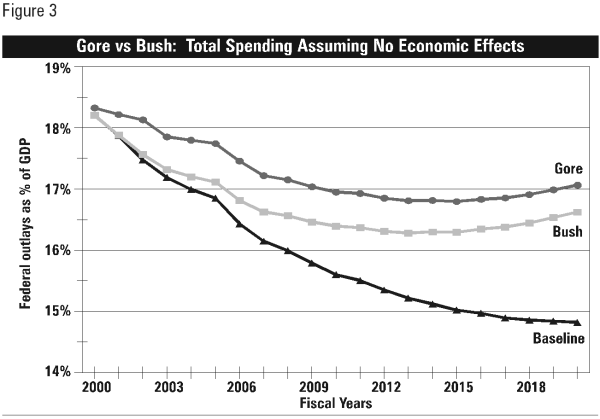
While total spending is shrinking relative to the economy, the mandatory part of the budget is growing. As Figure 4 shows, baseline spending for programs like Social Security, Medicare and Medicaid would steadily rise from 10.5 percent of GDP today to 11.4 percent in 2010 to 13.9 percent in 2020. Mandatory spending under Gore would climb at a more rapid pace, reaching 12.2 percent of GDP in 2010 and 14.5 percent in 2020. Acceleration under Bush would be somewhat slower, rising to 11.6 percent in 2010 and 13.9 percent in 2020.
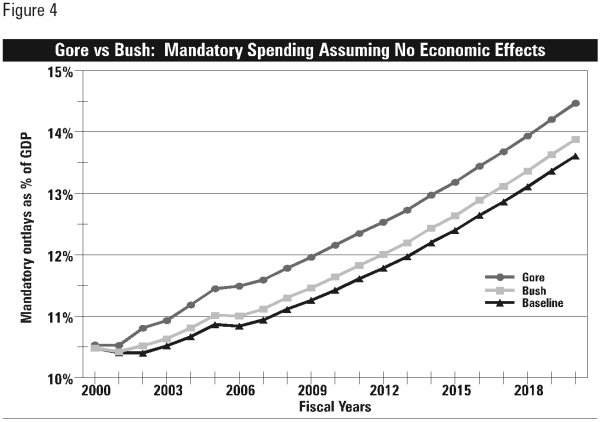
A Dynamic Analysis of the Gore and Bush Plans
Both the Gore and Bush plans would increase growth relative to the baseline. Gore’s positive economic effects would be minimal for three reasons. First, the Gore tax cuts are much smaller, about a fourth of Bush’s. Second, three-quarters of his tax cuts have little effect on incentives to work another hour or save and invest another dollar. What is more, the targeted tax cuts phase out at various incomes, leading to higher marginal rates that offset any positive incentive effects. Last, most of his tax increases fall on business to the detriment of the economy.
By 2010, as shown in Table 6, the Gore plan would increase the growth rate from the 2.7 percent in the baseline to 2.73 percent. The higher growth would raise employment levels by 0.14 percent (about 200,000 full-time jobs) and the stock of U.S. capital by 0.3 percent more than otherwise.
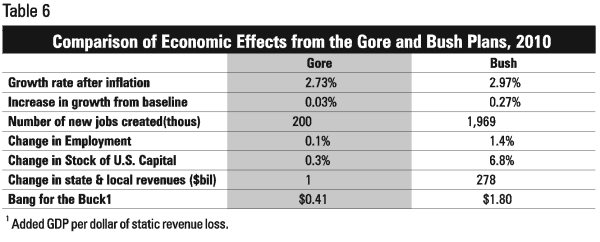
The Bush plan would have bigger, positive effects on the economy largely due to the cut in income tax rates and elimination of the estate tax. By 2010, the resulting drop in marginal tax rates would help raise the growth rate from 2.7 to 2.97 percent, boost employment by 1.4 percent (almost 2 million jobs) and increase the capital stock by 6.8 percent above baseline levels.
Budgetary Effects
Because federal revenues and spending depend on how the economy is doing, the positive economic effects of both plans would alter their budget outlooks. Table 7 compares the static and dynamic budget estimates for the Gore and Bush plans.
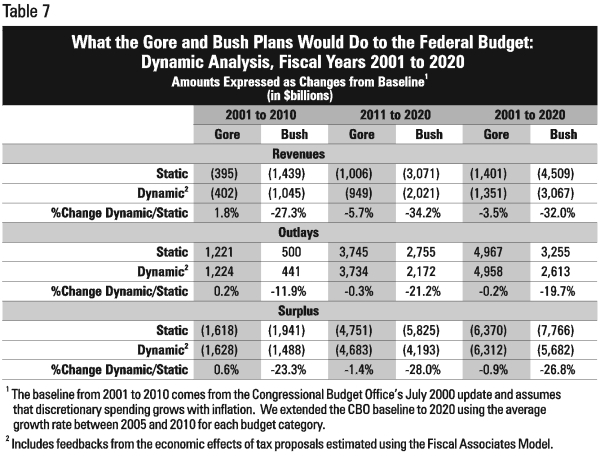
In the case of the Bush plan, higher growth would offset 27.3 percent of the static revenue losses between 2001 and 2010. That offset would rise to 34.2 percent between 2011 and 2020. Because Gore’s tax increases would be effective immediately while his cuts phase in, growth would be a little lower than that of the baseline for the first several years. As a result, the dynamic revenue loss would be slightly higher than the static during the first ten-year period. By the second period, the positive effects of the tax cuts would raise growth enough to offset 5.7 percent of the static revenue loss.
Put another way, the Bush tax cuts would provide more “bang for the buck.” For every dollar of static revenue loss, the Bush tax cuts would generate $1.80 in added output, compared to 41 cents for Gore.
The dynamic estimates for outlays are generally lower than the static estimates for both the Gore and Bush plans. The main reason is lower interest charges due to larger surpluses that result from smaller revenue losses when growth is factored in. The growth effects also move up the date the debt gets paid off under Bush from 2014 to 2013.
Conclusions
At stake in this election is the fate of the almost $4.6 trillion in surpluses that the federal government expects to collect over the next ten years. As Figure 5 shows, both candidates agree that the preponderance of the surpluses should go to paying off the debt. The use to which the remainder is put could dramatically affect the federal budget and general economy.
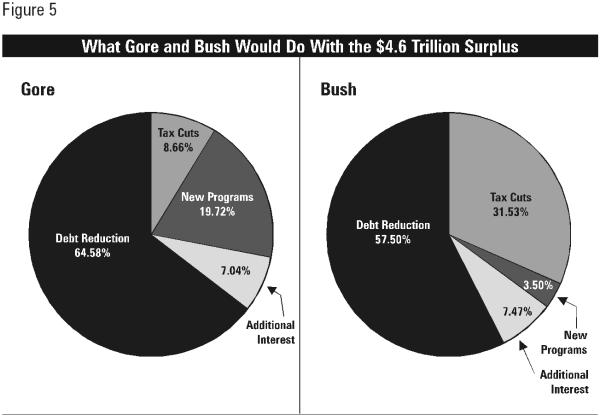
Bush would cut federal taxes a good deal more than Gore. Over the next ten years, federal taxes would average 20.1 percent of GDP under current law. Gore would lower that to19.5 percent and Bush to19.1 percent. Still, that leaves Gore with a higher tax rate than the 19.1 percent of the Clinton years. What is more, the tax burden under both Bush and Gore would stay well above the 18.1 percent of the Reagan-Bush years.
The Bush tax cuts would do more for the economy because they are larger and reduce marginal rates. Targeted tax cuts of both candidates, however, would further complicate the tax code and take revenue off the table that could be put to better use with broad-based tax reform.
Gore would increase federal spending a good deal more than Bush. Proposals of both candidates, however, have the potential to accelerate the growth in entitlements, exacerbating long-run financial problems.
Endnotes
- See “Prosperity for America’s Families: The Gore-Lieberman Economic Plan,” September 2000, available on the campaign website, www.Gore2000.com. Descriptions of the Bush plan may be found in “Renewing America’s Purpose” and cost estimates in ”Summary Budget September 5, 2000" which are available on the campaign website, www.Bush2000.com.
- For more discussion of specific proposals see Stephen J. Entin and Michael Schuyler, Towards a Better Tax System: The Bush Plan, Institute for Research on the Economics of Taxation (IRET) Policy Bulletin, No. 81, August 30, 2000.
- Many of the Gore tax proposals were proposed by President Clinton in his January budget. For more discussion of specific proposals see Stephen J. Entin and Michael Schuyler, The Gore Tax Plan: Redistribution, Not Reform, Institute for Research on the Economics of Taxation (IRET) Policy Bulletin, No. 82, September 20, 2000.
- To be eligible a taxpayer would have to have at least $5,000 in earnings, which can be combined earnings on a joint return, and must not be the dependent of another taxpayer. Age would be restricted to 18 to 701/2 and full-time college students would not be eligible. For other details see Chapter 4 of “Prosperity for America’s Families: The Gore-Lieberman Economic Plan.”
- CBO estimates the administration’s tax increases, which Gore adopted, would raise $205 billion over fiscal years 2001 to 2010. See Congressional Budget Office, An Analysis of the President’s Mid-Session Review of the Budget for Fiscal Year 2001, Corrected September 6, 2000, Table 5.
- The Gore plan reports the tobacco tax increase and miscellaneous revenue raisers as offsets to spending.
- The 2000 Annual Report of the Board of Trustees of the Federal Old-Age and Survivors Insurance and Disability Insurance Trust Funds, Washington, DC, March 30, 2000, Table III.B2.
- “The Gore-Lieberman Economic Plan,” Chapter 3.
- Gore proposes to give credit to parents for up to five years of child-raising which would increase benefits an average of $600 a year. He proposes to increase the benefit for widows and widowers from between one-half and two-thirds the couple’s combined benefits under current law to 75 percent.
- We have treated this option as a “paper” transfer with no economic or budgetary impact. The Bush proposal promises only the difference between what the trust fund versus the private account would have earned. This implies an as-yet-unspecified recoupment mechanism to hold the trust fund harmless.
- Congressional Budget Office, The Budget and Economic Outlook: An Update, Washington, DC, July 2000, Table 1-2. We extended the CBO baseline from 2010 to 2020 using the average growth rate between 2006 and 2010 for each budget category.
